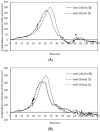Comparison of the Injury Mechanism between Pregnant and Non-Pregnant Women Vehicle Passengers Using Car Crash Test Dummies
- PMID: 35628021
- PMCID: PMC9141164
- DOI: 10.3390/healthcare10050884
Comparison of the Injury Mechanism between Pregnant and Non-Pregnant Women Vehicle Passengers Using Car Crash Test Dummies
Abstract
This paper analyzes the kinematics and applied forces of pregnant and non-pregnant women dummies sitting in the rear seat during a frontal vehicle collision to determine differences in the features of abdominal injuries. Sled tests were conducted at 29 and 48 km/h with pregnant and non-pregnant dummies (i.e., MAMA IIB and Hybrid III). The overall kinematics of the dummy, resultant acceleration at the chest, transrational acceleration along each axis at the pelvis, and loads of the lap belt and shoulder belt were examined. The belt loads were higher for the MAMA IIB than for the Hybrid III because the MAMA IIB had a higher body mass than the Hybrid III. The differences in the lap belt loads were 1119 N at 29 km/h and 1981-2365 N at 48 km/h. Therefore, for restrained pregnant women sitting in the rear seat, stronger forces may apply to the lower abdomen during a high-velocity frontal collision. Our results suggest that for restrained pregnant women sitting in the rear seat, the severity of abdominal injuries and the risk of a negative fetal outcome depend on the collision velocity.
Keywords: frontal motor vehicle collisions; negative fetal outcome; pregnant women.
Conflict of interest statement
The authors declare no conflict of interest.
Figures







Similar articles
-
Shorter pregnant women restrained in the rear seat of a car are at risk for serious neck injuries: Biomechanical analysis using a pregnant crash test dummy.Forensic Sci Int. 2018 Oct;291:133-137. doi: 10.1016/j.forsciint.2018.08.033. Epub 2018 Sep 1. Forensic Sci Int. 2018. PMID: 30196117
-
Analysis of the lack of restraint with and without belt pretensioning in 40.2 km/h rear impacts.Traffic Inj Prev. 2023;24(3):196-202. doi: 10.1080/15389588.2022.2121143. Epub 2022 Sep 22. Traffic Inj Prev. 2023. PMID: 36135987
-
The effect of unrestrained rear-seat passengers on driver mortality.J Trauma. 2006 Nov;61(5):1249-54. doi: 10.1097/01.ta.0000196587.46432.59. J Trauma. 2006. PMID: 17099537
-
Kinematics and dynamics of the pelvis in the process of submarining using PMHS sled tests.Stapp Car Crash J. 2012 Oct;56:411-42. doi: 10.4271/2012-22-0011. Stapp Car Crash J. 2012. PMID: 23625568
-
Seat belt pre-pretensioner effect on child-sized dummies during run-off-road events.Traffic Inj Prev. 2017 May 29;18(sup1):S96-S102. doi: 10.1080/15389588.2017.1312000. Epub 2017 Apr 12. Traffic Inj Prev. 2017. PMID: 28402687 Review.
Cited by
-
Pedestrian Safety in Frontal Tram Collision, Part 2: Laminated Glass as a Crucial Part of the Absorption and Deformation Zone-Its Impact Test and Analysis.Sensors (Basel). 2023 Nov 4;23(21):8974. doi: 10.3390/s23218974. Sensors (Basel). 2023. PMID: 37960673 Free PMC article.
References
-
- Duma S.M. Pregnant Occupant Biomechanics—Advances in Automobile Safety Research. SAE; Warrendale, PA, USA: 2011.
-
- Klinich K.D., Schneider L.W., Eby B., Rupp J.D., Pearlman M.D. Seated Anthropometry During Pregnancy. UMTRI; Ann Arbor, MI, USA: 1999. Report No.: UMTRI-99-16.
LinkOut - more resources
Full Text Sources
Research Materials

